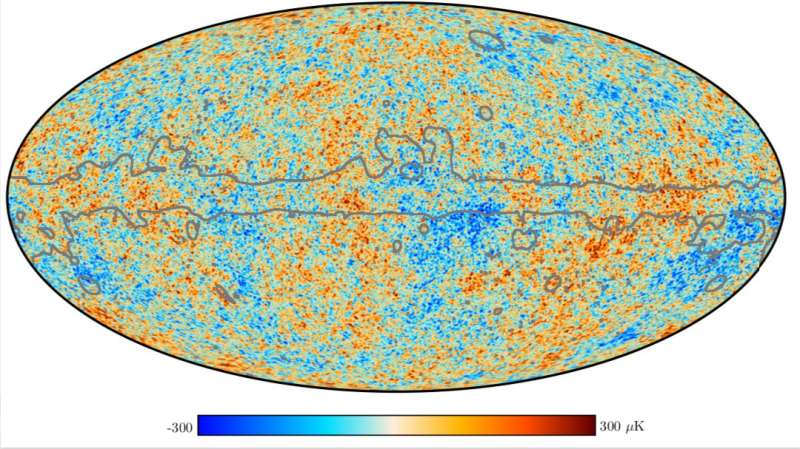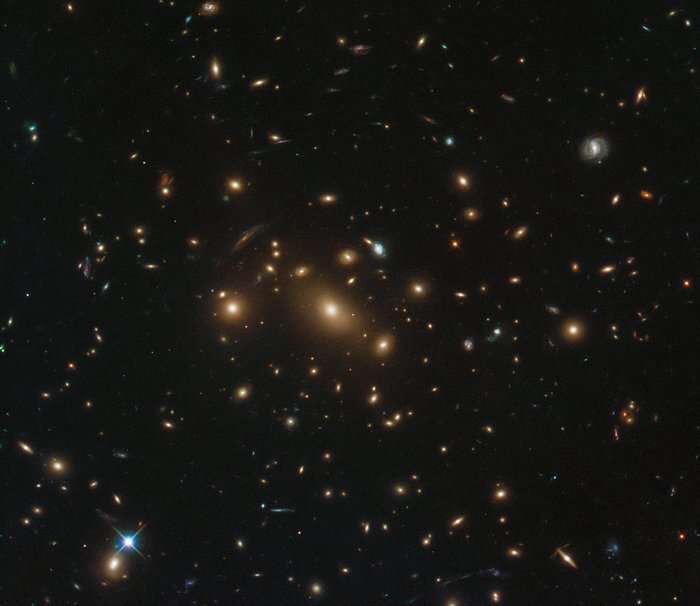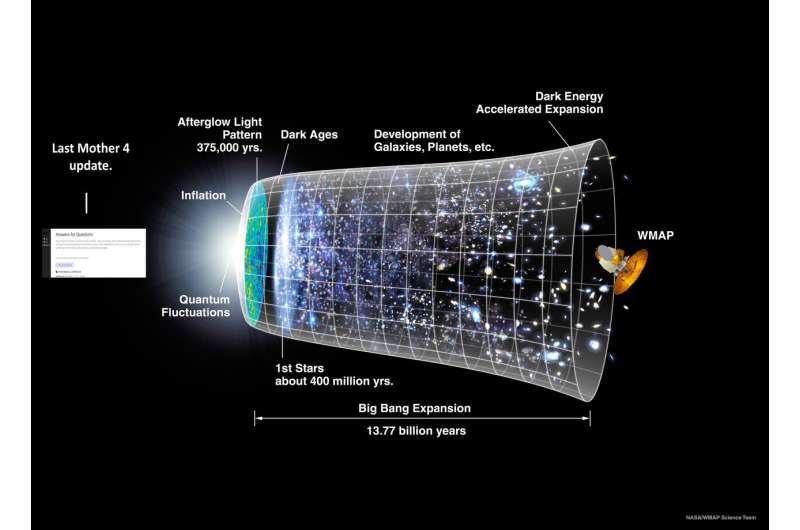June 24, 2019 feature
Model suggests how early dark energy could resolve the Hubble tension

The universe is continuously expanding, yet the exact rate at which it does so remains unclear, and has so far only been approximated using NASA's Hubble Space Telescope and other similar instruments. Moreover, in recent years, astronomers using the Hubble telescope have unveiled a discrepancy between the two primary techniques used for estimating the universe's expansion rate.
Essentially, measurements gathered by the Hubble telescope suggest that the universe is expanding much faster than what is inferred from cosmic microwave background (CMB) observations. This discrepancy, referred to as the Hubble tension, has sparked a growing interest within the physics research community, yet attempts at resolving it have so far been unsuccessful.
Researchers at Johns Hopkins University and Swarthmore College have recently proposed and tested an alternative model that could solve the Hubble tension. In their study, outlined in a paper published in Physical Review Letters, the researchers successfully applied a model of dark energy previously presented by Marc Kamionkowski (one of the authors), which describes it as evolving but non-interactive to the Hubble tension.
"Despite the lack of success, previous attempts at solving the Hubble tension allowed us to understand roughly what characteristics a solution should have," Vivian Poulin, one of the researchers who carried out the study, told Phys.org. "At the same time, we were working on testing consequences of string theory with cosmological observables, which predicts the existence of an "axiverse," i.e., a huge number of extremely light particles with very peculiar physical properties. We realized that a simple modification of the physical properties of these particles gave them the characteristics we needed in the context of the Hubble tension. Thus, we decided to push forward in this direction and test this alternative model."
Poulin and his colleagues are theoretical cosmologists, so they did not build an instrument to test their ideas. Instead, they used data collected during renowned research collaborations such as Planck's CMB observations and the SH0ES H0 measurements. Using this previously collected data, the researchers applied a model of early dark energy (EDE) to the Hubble tension.
Dark energy is a persistent mystery within current cosmological understanding, despite comprising approximately 70 percent of the universe's energy density. It was first discovered in 1998 by Adam Riess, Brian Schmidt, Saul Perlmutter and their respective teams during their supernovae observations.

"An EDE just means that these particles, in the cosmological context, act like a dark energy component (i.e. a fluid with negative pressure) at much earlier time than the current dark energy does," Poulin explained. "In practice, these particles modify the expansion rate of the universe around the time at which CMB photons were emitted (i.e., only 380,000 years after the Big Bang), increasing it slightly (by about 3 percent) compared to the standard prediction."
In their study, Poulin and his colleagues computed what the CMB would look like in the presence of an EDE component. Given the precision of the data gathered by Planck and used in their computations, the researchers' predictions were fairly detailed.
"We needed to figure out exactly how our model would behave, evolve and fluctuate, and how it would affect the cosmic microwave background, the oldest light in the universe," Tanvi Karwal, another researcher involved in the study, told Phys.org. "The CMB is complex and its shape must be calculated numerically, so we added code describing the EDE to a pre-existing code to extract cosmological information from the CMB."
Poulin, Karwal and their colleagues used a supercomputer to sample hundreds of thousands of different cosmologies. This allowed them to identify the cosmology that best fits existing observations of the universe. They found that this new cosmological model, which includes an EDE component, could solve the Hubble tension.
Essentially, the researchers observed that a slight modification of the universe's expansion rate in the remote past, as produced by an EDE, could resolve the Hubble tension. It is possible that the actual model tested in their study, which is merely a so-called toy model, is not realized in nature.
"This is not problematic, because in cosmology, what really matters are the dynamical properties of an ensemble of these particles (more accurately, it is their total energy density and pressure), and not so much their individual micro-physical properties," Poulin said. "In fact, there already are alternative realizations of the EDE proposed after our work was published, whose collective properties are similar to the one we proposed."

Overall, the work of Poulin, Karwal and their colleagues aids the current understanding of when and by how much EDE must have been dynamically important, which could ultimately inform the development of more effective cosmological models. Given the accuracy of Planck data, it is highly nontrivial that a fluid that represents up to 10 percent of the universe's energy density at very early times would not significantly affect the CMB, thus showing that it does required substantial numerical calculations.
"My main takeaway from this project is that anomalous cosmological observations can help us to explore new physics," Karwal said. "This research has inspired other groups to investigate similar models of EDE as a solution to the Hubble tension. We have some more work to do in refining and understanding our EDE model, but are also interested in different solutions to the Hubble tension altogether."
The researchers are now planning to test their model further in several ways. First, they would like to use it to learn as much as they can about the properties of EDE. In fact, although there are a number of alternative models of EDE, the resolutions produced by these models are not as effective as those generated by the new one. Poulin, Karwal and their colleagues would like to understand why their model produces better predictions, as their findings highlight the sensitivity of data to the characteristics of EDE.
"We also want to see whether there are additional signatures of these particles in cosmological observables," Poulin said. "For instance, we already realized that next-generation CMB experiments (such as Simons Observatory and CMBS4) could test this model independently of the supernovae observation. It means that one could tell unambiguously that this fluid exists in nature without needing to invoke the Hubble tension. But we also showed that these models can affect the statistical properties of ensembles of galaxies, for which we have numerous observations."
In the future, new data collected using space instruments such as the EUCLID satellite and LSST telescope could improve the accuracy and scope of the measurements gathered by this team of researchers. The researchers believe that these observations could also contain the fingerprint of EDE, though achieving an accurate prediction of this fingerprint will require additional work that goes way beyond the numerical computations they performed.
More information: Observational evidence from supernovae for an accelerating universe and a cosmological constant. arXiv:astro-ph/9805201. arxiv.org/abs/astro-ph/9805201
Measurement of omega and lambda from 42 high-redshift supernovae. arXiv:astro-ph/9812133. arxiv.org/abs/astro-ph/9812133
Marc Kamionkowski et al. Dark Energy from the String Axiverse, Physical Review Letters (2014). DOI: 10.1103/PhysRevLett.113.251302
Vivian Poulin et al. Early Dark Energy can Resolve the Hubble Tension, Physical Review Letters (2019). DOI: 10.1103/PhysRevLett.122.221301
Journal information: Physical Review Letters
© 2019 Science X Network



















